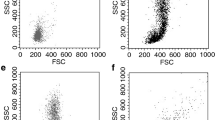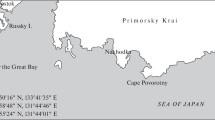Abstract
In order to characterize in more detail hemocytes from Mytilus edulis and establish links between histological and cytological featues, monoclonal antibodies (MABs) were prepared using hybridoma technology. Five MABs were identified and their reactivity patterns were analyzed with both immunoperoxidase and ultrastructural immunogold labelling. Four MAB classes were identified by their immunostaining patterns. Optical and ultrastructural examination revealed that Class I MAB reacted specifically with basophilic granulocytes (granulocytes containing small granules). Class II and III MABs differed in the intensity of their indirect immunofluorescence and degree of immunoperoxidase labelling, but all recognized both basophilic and eosinophilic granulocytes. Epitopes recognized by Class IV MABs were not always present in basophilic granulocytes, whereas they were always expressed in the eosinophilic granulocytes (granulocytes containing large granules) and could constitute differentiation antigens which progressively form during the maturation process. Molecular weights of the proteins recognized by these MABs were determined by Western blotting. It is concluded that immunostaining can identify at least three hemocyte types in M. edulis.
Similar content being viewed by others
References
Adema CM, Van der Knapp WPW, Sminia T (1991) Molluscan hemocyte-mediated cytoxicity, the role of reactive oxygen intermediates. Rev aquat Sciences 4:201–223
Bachère E, Chagot D, Grizel H (1988) Separation of Crassostrea gigas hemocytes by density gradient centrifugation and counter-flow centrifugal elutriation. Devl comp Immun 12:549–559
Bachère E, Hervio D, Mialhe E, Grizel H (1990) Evidence of neutralizing activity against T3 coliphage in oyster Crassostrea gigas hemolymph. Devl comp Immun 14:261–268
Bayne CJ, Moore MN, Carefoot TH, Thompson RJ (1979) Hemolymph functions in Mytilus californianus: the cytochemistry of hemocytes and their responses to foreign implants and hemolymph factors in phagocytosis. J Invert Path 34:1–20
Cheng TC (1981) Bivalves. In: Ratcliffe NA, Rowley AF (eds) Invertebrate blood cells. London, Academic Press, pp 233–270
Dikkeboom R, Tijnagel JMG, Van der Knapp WPW (1988) Monoclonal antibody recognized hemocyte subpopulations in juvenile and adult Lymnea stagnalis: functional characterization and lectin binding. Devl comp Immun 12:17–32
Dikkeboom R, Van der Knapp WPW, Maaskant JJ, De Jonge AJR (1985) Different subpopulations of haemocytes in juvenile, adult and Trichobilharzia ocellata infected Lymnea stagnalis: a characterization using monoclonal antibodies. Z ParasitKde 71:815–819
Falkenberg U, Leenen PJM, Falkenberg FW (1989) Characterization of mouse macrophage differentiation antigens by monoclonal antibodies. Cell Immun 124:77–94
Hughes TK, Smith EM, Barnett JA, Charles R, Stefano GB (1991) LPS stimulated invertebrate hemocytes: a role for immunoreactive TNF and IL-1. Devl comp Immun 15:117–122
Hughes TK, Smith EM, Chin R, Cadet P, Sinisterra J, Leung MK, Shipp MA, Scharrer B, Stefano GB (1990) Interaction of immunoreactive monokines (interleukin 1 and tumor necrosis factor) in the bivalve mollusc Mytilus edulis. Proc natn Acad Sci USA 87:4426–4429
Jeurissen SHM, Janse EM, Koch G, De Boer GF (1988) The monoclonal antibody CVI-CHNL-68.1 recognize cells of the monocyte-macrophage lineage in chickens. Devl comp Immun 12:855–864
Klebanoff SJ, Clark RA (1978) The neutrophil: function and clinical disorders. Elsevier, North Holland Biomedical Press, Amsterdam
Lemieux S, Ouellet-Talbot F, Lusignan Y, Morelli L, Labreche N, Gosselin P, Lecomte J (1991) Identification of murine natural killer cell subsets with monoclonal antibodies derived from 129 anti-C57BL/6 immune spleen cells. Cell Immun 134:191–204
Mialhe E, Boulo V, Grizel H (1988) Bivalve mollusc cell culture. In Fisher, WS (ed) Disease processes in marine bivalve molluscs. American Fisheries Society. Bethesda, Md, pp 311–315
Miller NW, Bly JE, Van Ginkel F, Elisaesser CF, Clem LW (1987) Phylogeny of lymphocyte heterogeneity: identification and separation of functionally distinct subpopulations of channel catfish lymphocytes with monoclonal antibodies. Devl comp Immun 11:739–747
Moore MN, Lowe DM (1977) The cytology and cytochemistry of the hemocytes of Mytilus edulis and their responses to experimentally injected carbon particles. J Invert Path 29:18–30
Noë D, Bachère E, Mialhe E (1993) Phagocytosis associated chemiluminescence of hemocytes in Mytilus edulis (Bivalvia) Devl comp Immun 17:483–493
Noël D, Boulo V, Chagot D, Mialhe E, Paolucci F, Clavies C, Hervaud E, Elston RA (1991) Preparation and characterization of monoclonal antibodies against neoplastic hemocytes of Mytilus edulis (Bivalvia). Dis aquat Organisms 10:51–88
Pipe RK (1990a) Differential binding of lectins to haemocytes of the mussel Mytilus edulis. Cell Tissue Res 261:261–268
Pipe RK (1990b) Hydrolytic enzymes associated with the granular haemocytes of the marine mussel Mytilus edulis. Histochem J 22:595–603
Pipe RK (1992) Generation of reactive oxygen metabolites by the haemocytes of the mussel Mytilus edulis. Devl comp Immun 16:111–122
Rasmussen LPP, Hage E, Karlog O (1985) An electron microscope study of the circulating leucocytes of the marine mussel Mytilus edulis. J Invert Path 45:158–167
Reinisch CL, Charles AM, Troutner J (1983) Unique antigens on neoplastic cells of the soft-shell clam Mya arenaria. Devl comp Immun 7:33–39
Renwrantz L (1990) Internal defence system of Mytilus edulis. In: Stefano GB (ed) Neurobiology of Mytilus edulis. Manchester University Press, Manchester and New York, pp 256–275
Renwrantz L, Stahmer A (1983) Opsonizing properties of an isolated hemolymph agglutinin and demonstration of lectin-like recognition molecules at the surface of hemocytes from Mytilus edulis. J comp Physiol 149:535–546
Takahashi K, Mori K, Nomura T (1986) Occurrence and characterization of lysozyme in the marine bivalves. Bull Jap Soc scient Fish 52:863–868
Takeya M, Hsiao L, Shimokawa Y, Takahashi K (1989) Heterogeneity of rat macrophages recognized by monoclonal antibodies: an immunohistochemical and immunoelectron microscopic study. J Histochem Cytochem 37:635–641
Yoshino TP, Granath WO (1983) Identification of antigenically distinct hemocyte subpopulations in Biomphalaria glabrata (Gastropoda) using monoclonal antibodies to surface membrane markers. Cell Tissue Res 232:553–564
Author information
Authors and Affiliations
Additional information
Communicated by J. M. Pérès, Marseille
Rights and permissions
About this article
Cite this article
Noël, D., Pipe, R., Elston, R. et al. Antigenic characterization of hemocyte subpopulations in the mussel Mytilus edulis by means of monoclonal antibodies. Marine Biology 119, 549–556 (1994). https://doi.org/10.1007/BF00354317
Received:
Accepted:
Issue Date:
DOI: https://doi.org/10.1007/BF00354317




